We have a new King. I’m having trouble with his name. I can’t say “King Charles” without finishing with “King Charles Spaniel“. Apparently the Queen’s son is the third Charles to sit on the throne — another phrase I have trouble with as ‘sitting on the throne’ means something scatological in my dialect, here in the Southern colonies.
Now we have a new King of England, I’m wondering, who was the first?
WHO WAS THE FIRST KING OF ENGLAND?
His name was Athelstan. Born in 895, the first king of England ruled 925-939, which was also the year he died. He died at the age of 45.
Athelstan sounds like a former territory of the Soviet Union. If you’re after a secure password, try Æðelstan:
Derived from the Old English elements æðel “noble” and stan “stone”. This was the name of a 10th-century English king, the first to rule all of England. The name was rarely used after the Norman Conquest, though it enjoyed a modest revival (as Athelstan) in the 19th century.
Behind The Name
Apparently, the guy’s name was revived in Britain the latter half of the 19th century.
Why? Was he such a terrible King that to name your son Athelstan was akin to calling your kid “Hitler”? Did everyone need to completely forget about his awfulness before thinking, “You know what? That’d make a very nice name for a baby.”
Or was King Athelstan unfairly remembered for centuries, only later redeemed in our collective memory? Was he a good guy? Let’s take a look.
CAN WE SAY ATHELSTAN WAS THE KING OF ENGLAND?
Well, technically he was King of the Anglo-Saxons and then be became King of the English when he unified the territories into England.
“King of the English” is a good way of putting it.
WHAT DID KING ATHELSTAN LOOK LIKE?
Noteworthy point: Athelstan was the first to wear a crown and not a helmet. The crown has no practical value and is purely a symbol of royal power.
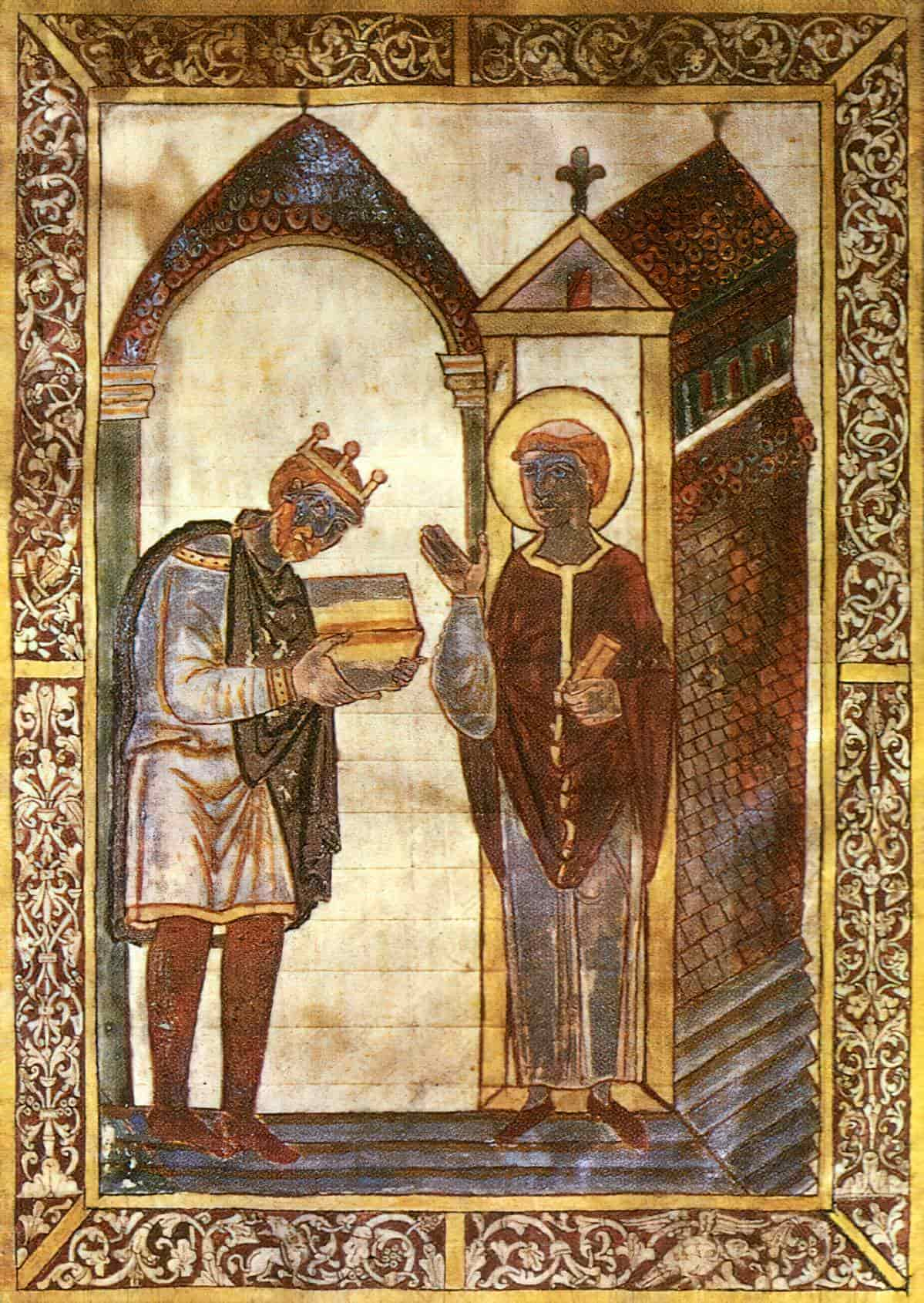
According to the image below, Athelstan looks suspiciously like Jesus. As in, the Jesus hanging on Catholic relatives’ wall, not how Jesus would have looked in the slightest. If even Jesus doesn’t look a bit like Jesus, I doubt King Aethelstan looked a single bit like this:
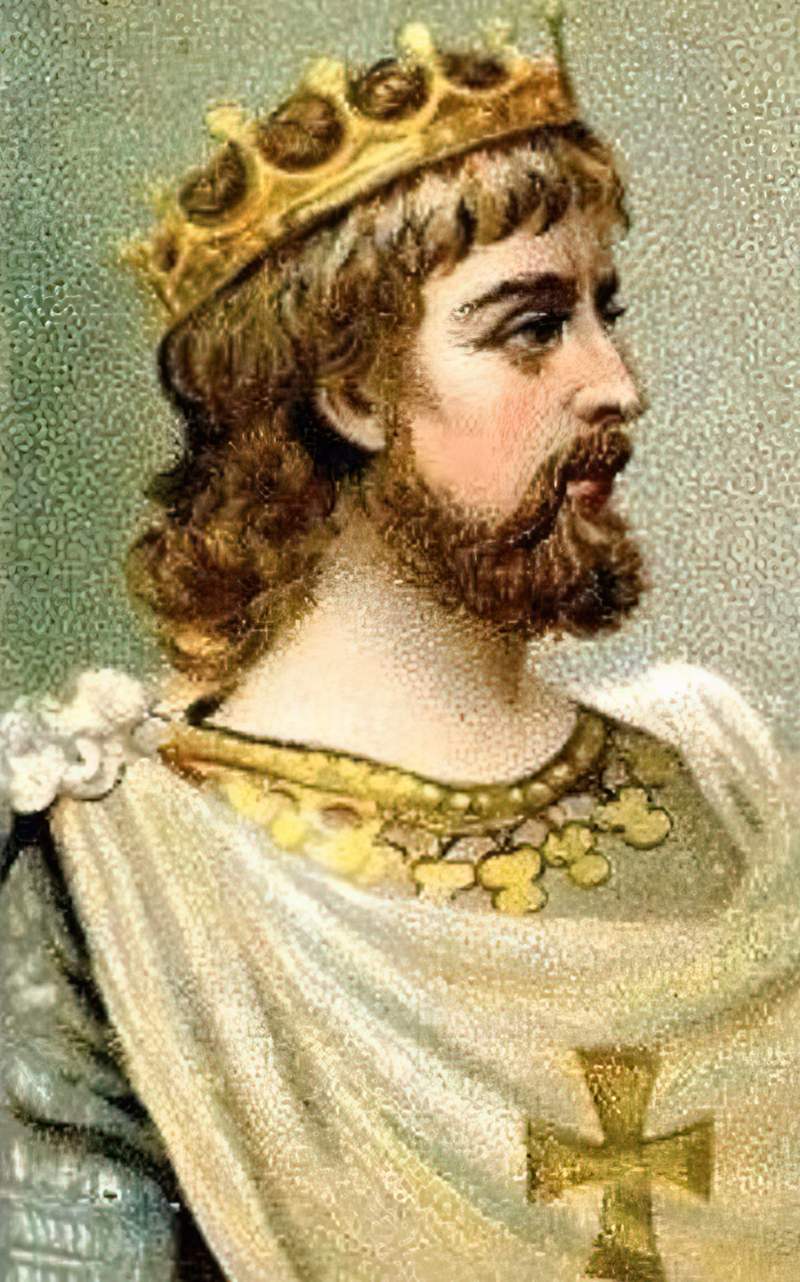
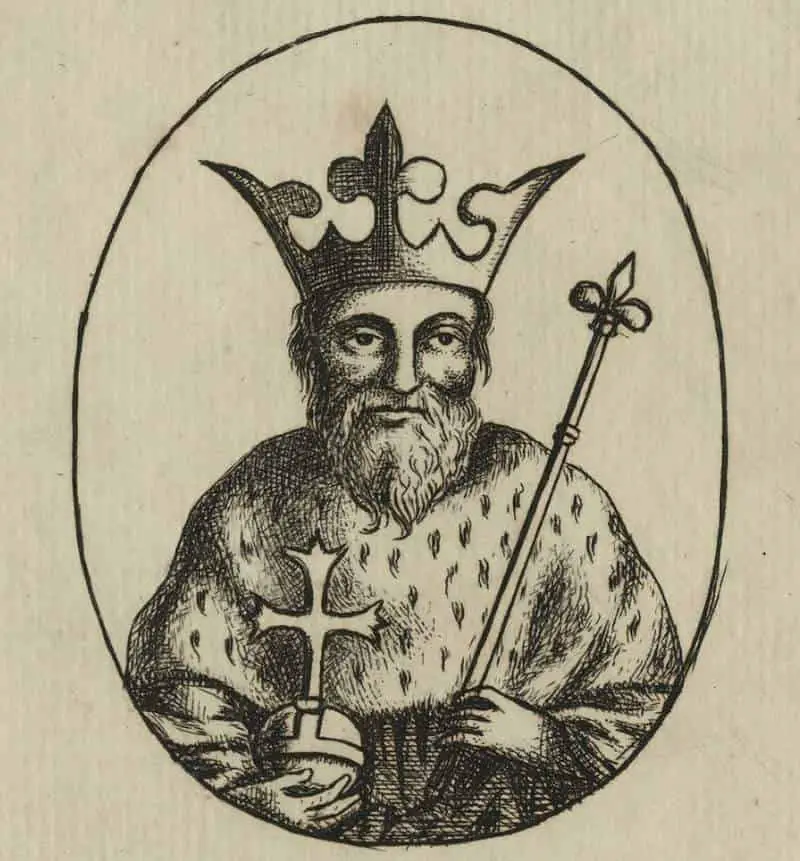
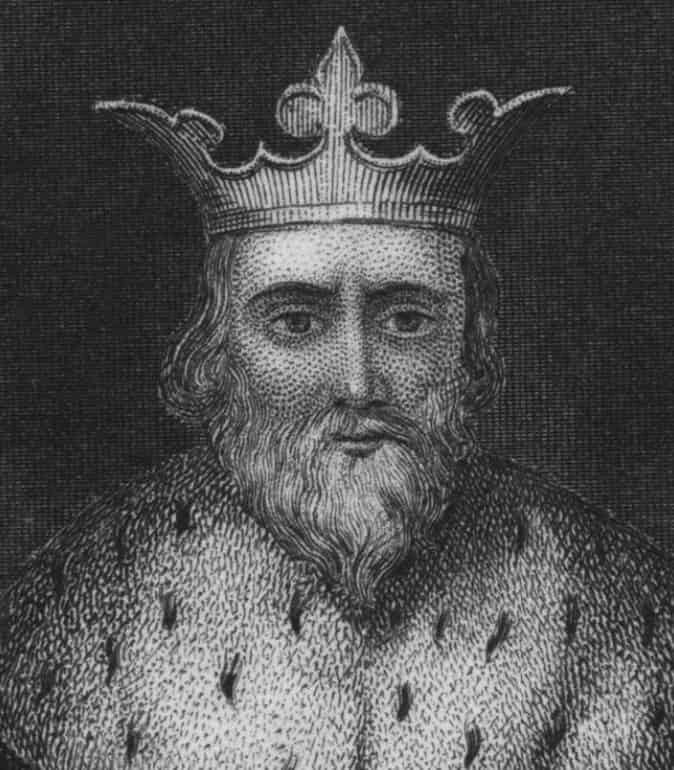
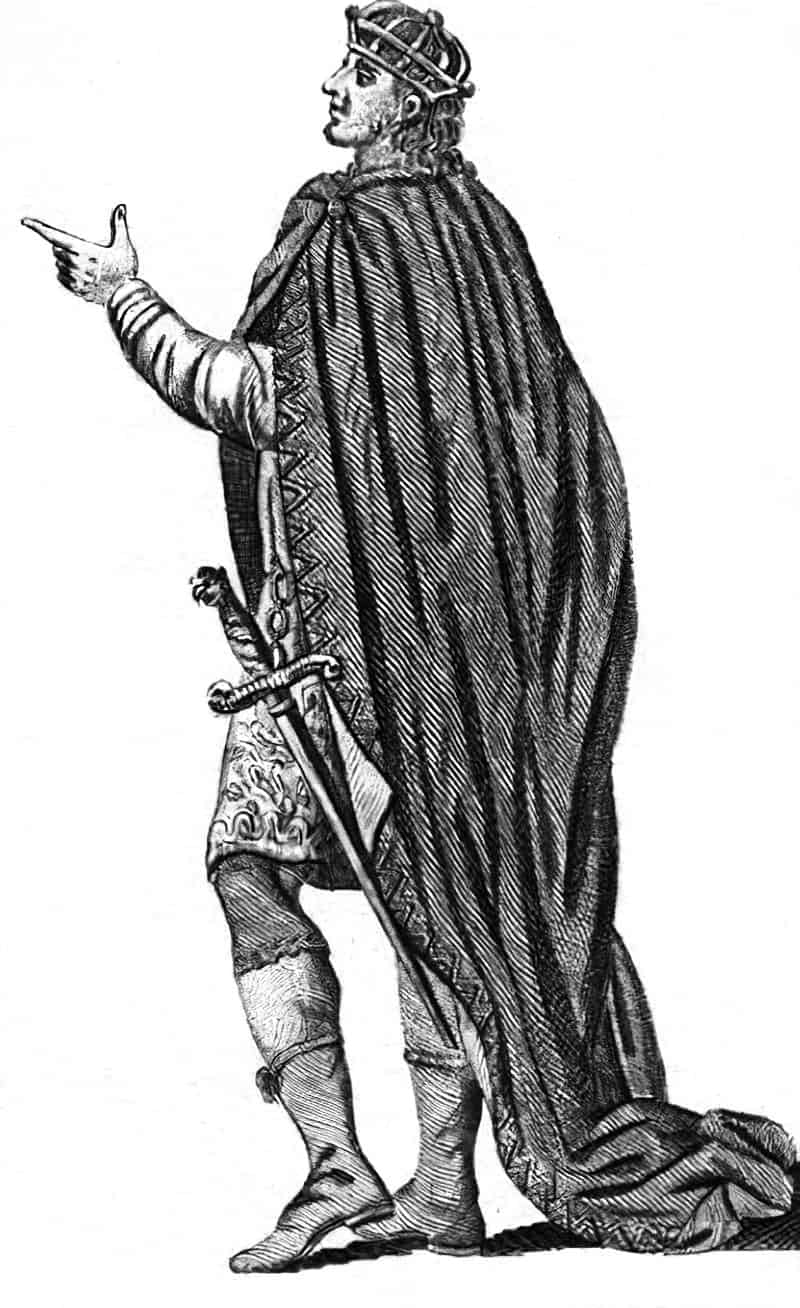
King Athelstan was the first to put his own image on the coinage. Speaks to a healthy self-confidence, don’t you think? Here he is on the coin:
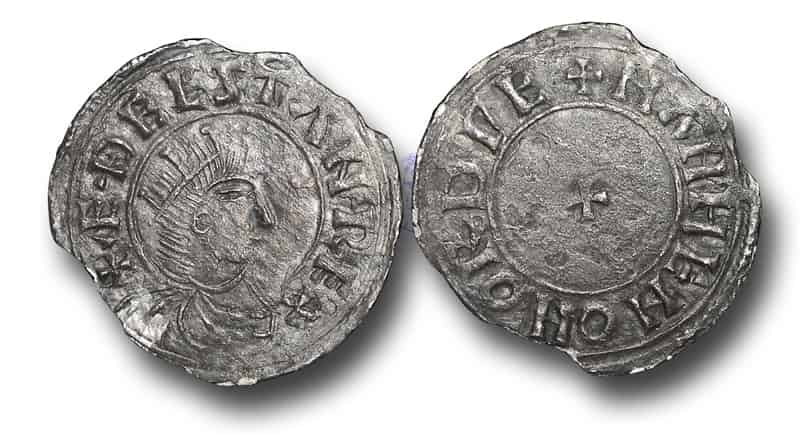
What we know (or have been told) about Athelstan’s appearance:
- flaxen mullet hair
- a beard, at least when he died
- slim build
- he was white
- he didn’t have access to shampoo and conditioner
- he wore what we now call a ‘three stalk’ crown. We might assume he wore his grandfather’s crown, which was apparently studded with beautiful emeralds. However, Oliver Cromwell melted it down.
- he was confident enough to put himself on a coin, which no one else had done before him
- he had a nose, mouth and at least one ear
- and either a well-defined brow or an artist who liked to draw brows
Historians know far more about what happened during the life of Alfred the Great than what happened during the life of Athelstan. Documentary evidence simply doesn’t exist.
What we do know comes from a guy called William Malmesbury, who wrote in the 12th century. He had a special interest in Athelstan because King Athelstan was buried at Malmesbury. Historians speculate that Malmesbury had access to texts which no longer exist, but no one can be certain about that. We don’t know how reliable he was as an historian. He wrote in a difficult-to-understand, bombastic prose which was likely heavily romanticised.
The supposed missing text: The Wars of King Athelstan. It may have been written in both verse and prose.
Whatever we know about Athelstan today comes from a hodge-podge collection from all over the place, including notes written in Latin and Norse. One difficulty is drawing a distinction about who the guy really was versus how he wished to project himself. (Did his image on the coin look a single thing like him, or was it a Medieval Insta filter?)
WHERE WAS ATHELSTAN BORN?
Athelstan was born in Wessex. The Kingdom of Wessex was an Anglo-Saxon kingdom in the South of Great Britain.
His grandfather was Alfred the Great, king of Wessex between 871 and 899. These days, far more people know about Alfred the Great than King Athelstan.
Alfred the Great is famous for saving England from the Danes.
WHAT WAS ATHELSTAN’S CHILDHOOD LIKE?
- His mother wasn’t married to the King (Edward the Elder), at least not when Athelstan was young. His mother was one of the King’s consorts.
- Athelstan was the only child of his mother. We know very little about his mother. Edward the Elder had three wives in succession, making him more of a serial monogamist rather than a polygamist. He had ten children altogether. Athelstan was one.
- When his father left his mother for another woman for better political advantage, he probably moved to Mercia.
- Historians have deduced that Edward the Elder probably put Athelstan’s mother aside to marry a leading noblewoman of Wessex. He would have done this to gain recognition for the throne.
- Athelstan would only just remember his famous grandfather. Most of what he learned about his grandfather’s life would have been told to him when he was older.
- He grew up during a period of massive reconstruction after the Viking invasions — a large force of pagan Norwegians and Danes intent on pillaging as much of England as they could. They started with conquering churches in the 790s. 75 years later they’d conquered. The Anglo-Saxons were terrified of these savages who were into scary things like human sacrifice.
Dragon Lords: The History and Legends of Viking England
For all of their prominence in the popular imagination today, the historical record of the Viking presence in England is limited, with much of what we know about them dependent upon the literary accounts attached to it. In Dragon Lords: The History and Legends of Viking England (Bloomsbury Academic, 2019), Eleanor Parker deconstructs these accounts to ascertain what they reveal both about the Vikings and their legacy for medieval England. Focusing on the narratives of Ragnar Lothbrok and his sons, Siward, Guy of Warwick, and Havelok, she draws out similarities that deepen our understanding of who they were. By analyzing these stories, she shows how the interpretations of the Danes changed over time, as their evolution into a more hostile and alien presence gave them a more adversarial role in shaping England’s national identity than was the case.
New Books Network
- It was Athelstan’s grandfather, “Alfred the Great”, who persuaded Danish leader Guthram to quit the mass pillaging and become a Christian.
- Danes ruled large parts of central and eastern England. Their law was called Danelaw. Danish settlement in Yorkshire was high. (If an English town ends in -by, e.g. Whitby (cf. Dracula) this means it was a Danish settlement. Ditto for places ending in Thorpe.
- By the time Athelstan came along, there wouldn’t have been much looking back. Focus was on rebuilding of a ruined state.
- But offsetting this state of mind for Athelstan himself, his own father was successfully re-conquering the area of Dane law (which is now England, but which was then under Scandinavian control — the era of The Vikings). So Athelstan saw his father as powerful and successful.
WHERE DID ATHELSTAN LIVE?
- He was crowned at Kingston-upon-Thames in September 924.
- Historians believe he may have spent part of his childhood in Mercia during the early years of the 10th century, after his father had remarried.
- He may have had a palace at Brokenborough (a village and civil parish about 2.4 km northwest of Malmesbury, Wiltshire)
- When Athelstan’s father died in 924, Athelstan was on the Northwestern border of his kingdom in Cheshire, with his father. (The next eldest brother was in Winchester. Athelstan declared himself King in Mercia, and so did this next eldest brother, but in Winchester. This may have led to a divided kingdom, except conveniently for Athelstan the Winchester King brother died three weeks later.)
- We do know Athelstan had a villa at Norton (a market town in the Borough of Stockton-on-Tees, County Durham)
- He also had land at Foxley (a village and civil parish in the English county of Norfolk).
- He died at his palace in Gloucester 27th October 939.
- Breaking tradition, he was buried at Malmesbury because he loved it there. But no one knows where exactly. (Malmesbury is a town and civil parish in north Wiltshire.)
WHAT SORT OF PLACE WAS LATE NINTH CENTURY ENGLAND?
THE PERIOD LEADING UP TO ATHELSTAN’S LIFE
- The Anglo-Saxons had migrated from northern Europe to England in the fifth and sixth centuries (the Early Middle Ages). So in the scheme of things, they hadn’t been in England for long.
- Starting in the 590s, across 3-4 generations, the English kings converted to Christianity.
- If you learned how to read, this was done through the church. The most literate group by far were monks.
- Churches collected 10% of people’s earnings.
- England became one of the wealthiest kingdoms in Europe because of good farming conditions and a strong culture of trade between towns and villages.
- The social hierarchy was: Royalty at the top, Major Nobility, Minor Nobility and then the Freemen with Serfs under them. Freemen were commoners who were allowed to own land. Serfs were slaves. They owned nothing in their own names, working in exchange for food and shelter.
- Major towns were fortified (London, York, Winchester, Oxford.)
- Most people lived in villages.
- People believed supernatural things, e.g. that every village had a witch.
- England changed A LOT between the beginning and end of the ninth century. The Viking invasions had a huge impact. At the beginning of the century there had been three major kingdoms (Mercia, Wessex, North Umbria). By the end of that century only the Kingdom of Wessex remained.
- The Viking invasions caused an economic downturn. Old towns which had thrived up until the eighth century disappeared from the archaeological record by the end of the ninth century.
- The area was made up of a series of different kingdoms: The Cornish, The Welsh, The Cumbrians, The Scots, The Northumbrians, the Viking Kingdom (based around York). These are all potentially hostile areas to Athelstan when he comes to power.
DURING ATHELSTAN’S LIFE
- The job of a King: strong military leadership and successful defence of your borders. When leaders felt they had strong borders, they started wars with their neighbours to gain control of a larger area.
- His grandfather had set up a whole bunch of little fortified towns which were all within a day’s march of each other. This was called The Iron Ring. These centres were for defence and also centres for trading. Athelstan made sure these were maintained annually.
- We know that King Athelstan exerted control over the northern Viking regions but we don’t know much about how he did that. He married off his half-sister to a Viking King up there. (The King conveniently died a year after that.) We know there was a meeting up there. The Scots Kings and so on up there accepted Athelstan as their overlord after that, as did the Welsh kings. It may have been a bloodless coup. In 934 we know he pulled down a fortress which had been constructed by the Danes. There is good documentation around this campaign. We know he took his own army as well as the armies of those other Kings. But it was a lot more messy than that. It was a battle for power between many different personalities.
- In 937 King Athelstan entered his most successful battle. We have it recorded in a long, highly-stylized poem, remembered afterwards as The Great War, even in the 980s. We also know about this battle from Scandinavian sources e.g. in a thirteenth century saga.
- King Athelstan had no time for thieves, but showed grace towards thieves under the age of twelve, showing he had a concept of ‘childhood’.
- He wasn’t into incarceration. He much preferred outlawing (removal from the kingdom). Structures in place ensured this happened, i.e. monthly meetings with the Reeves, who were responsible for implementing the outlawing.
- By the time Athelstan died, he didn’t just see himself as King of England, but of Britain. His big plan was to convert everyone to Christianity. That said, he had never refused to interact with another ruler if they weren’t Christian, and refused to be converted.
WAS ATHELSTAN A GOOD KING?
Some historians consider Athelstan one of England’s greatest kings. He was either smart enough or lucky enough to rule during one of the most peaceful periods in history.
In total, Athelstan served 14 years on the throne. He achieved a lot in that time.
UNIFICATION OF ENGLAND
England was unified by Athelstan in 927. He did a lot to establish law and order. He believed he had a duty of charity, which suggests he cared about equality. Under his rule, landowners had to pay a set amount to the poor and also free one enslaved person per year. He also made a law that church-goers had to pay tithes to the church. He was big into church.
ATHELSTAN HAD NO TIME FOR THIEVES
He had his own strong sense of morality. Couldn’t stand thieves. He believed theft and corruption were evidence of societal breakdown and had no tolerance for that. He reformed the system of currency to avoid corruption. There are so many references to theft in Athelstan’s law reform, it seems the guy was obsessed with it. But historians believe ‘theft’ was proxy or metaphor for a wider problem: general breach of the peace.
RULING STYLE
Athelstan’s way of ruling was very effective and it was a method he thought of himself. He gave ealdormen (mini-kings) authority over larger territories, and trusted them enough to leave them to it. In turn, these ealdormen served King Athelstan. This broad network gave Athelstan a large reach of rule.
He was big into education and believed his people should be educated.
ATHELSTAN LOVED BOOKS
He was a keen collector of things, including books. Unfortunately, books of that time haven’t survived. Some scholars say Beowulf was composed by someone in Athelstan’s court.
The Venerable Bede was a big influence on King Athelstan. Bede was one of the greatest scholars of the Anglo-Saxon period. He produced a large number of works on subjects as varied as science, music, poetry and biblical commentary. He is most famous for his Ecclesiastical History of the English People.
He may have orchestrated a translation of The Bible into Old English.
ATHELSTAN RESTED ON SUNDAYS
He banned Sunday trading, though he supported commerce.
ATHELSTAN AND HIS SISTERS
In line with the ideas of the time, women were considered chattel. He married off female relatives to make good alliances between regions, especially Europe. You might say he had a European foreign policy. He dispersed his half-sisters around the place so that whoever won in any given battle, the victor would be his brother-in-law, their children his nephews. It would have helped Athelstan immensely that his sisters were beautiful. Kings wanted to marry them after Athelstan offered them up.
ATHELSTAN AND EDWIN
He wanted to kill his brother Edwin, but only because he believed Edwin wanted to kill him. Well, to be fair, Athelstan didn’t want to kill him. He only wanted to be rid of him. So Athelstan sent Edwin out to sea in a leaky boat with no sail, no food, no water. Edwin didn’t wait for dehydration to kick in. He threw himself into the sea and drowned. (Though how we would know that, I have no idea.)
But it sounds like Athelstan had something of a conscience, which is not something we can say for sociopaths. He felt bad about Edwin and did penance. This may explain his many charitable efforts.
WAS QUEEN ELIZABETH RELATED TO ATHELSTAN?
Athelstan was the 30th great-granduncle of Queen Elizabeth II. This bloodline goes back 1,209 years, covering 37 generations.
This makes him the 31st great-granduncle to King Charles-not-the-Spaniel.
HOW OLD WAS ATHELSTAN WHEN HE BECAME KING?
Athelstan was 30 years old when he came to the throne in 924.
WHY DID ATHELSTAN NEVER MARRY?
We don’t know why Athelstan never married and never had children. Nor will we ever know for sure. It is very unusual. Kings were expected to marry Queens and produce offspring. Instead, King Athelstan concerned himself with marrying-off close relatives without getting married himself.
- Since gay people have always existed, it’s possible Athelstan was gay. But since marriage was about pragmatism until very recently, a gay king would likely have married a woman anyhow.
- It’s easy to forget the invisible orientation, but perhaps King Athelstan was asexual. This would explain why there’s no record of illegitimate children, either. When you don’t experience sexual attraction, you’re far less likely to run around having lots of sex.
- He may have chosen a life of celibacy for religious reasons. This choice may also be influenced by queerness, as most straight men who enter the church with expectations of celibacy seem to have huge issues maintaining it. As a King in the 10th century, you have sexual access to pretty much anyone you choose. If he chose celibacy for religious reason, it’s more likely queerness was a factor because celibacy as a religious motivation didn’t come along for another two centuries.
- Another theory assumes King Athelstan was a very magnanimous person, who appeased his family by refusing to marry and beget heirs. He was never first in line to the throne but the older brother died just sixteen days after their father. Dodgy, much? There’s no evidence to say this was a suspicious death. Which is more than we can say about Athelstan’s involvement in the death of his next youngest brother, Edwin. Let’s say that’s all aboveboard. Athelstan’s extended family of half-siblings and stepmothers must have felt Athelstan’s ascension to the throne was nothing more than dumb luck. Perhaps Athelstan said, “Okay, let me be King in peace but I won’t have kids. Your kids can inherit.” This would be unusual. That’s not how people typically work. For the heterosexual and procreatively-inclined, babies come along whether planned or unplanned.
- Perhaps he had between one and many unrecorded lovers, but never produced heirs because he was infertile.
- Perhaps he had children who died in infancy.
- Perhaps he had enough on his plate being King. He did foster Louis, the son of his half-sister. After marrying her off the husband was deposed, so Athelstan took on the care of Louis. He helped the kid regain his political power in France.
- Maybe he just didn’t want to be a family man. And because he was in charge, he didn’t have to. He certainly had many other interests, and plunged himself into his work.
The header image is an artificially generated illustration of a castle. It would be great to have archaeological evidence of Malmesbury Castle, but no such record exists.
REFERENCES INCLUDE
The “Athelstan” episode of In Our Time podcast
ON OLD ENGLISH
Old English is the language you think you know until you actually hear or see it. Unlike Shakespearean English or even Chaucer’s Middle English, Old English—the language of Beowulf—defies comprehension by untrained modern readers. Used throughout much of Britain more than a thousand years ago, it is rich with words that haven’t changed (like word), others that are unrecognizable (such as neorxnawang, or paradise), and some that are mystifying even in translation (gafol-fisc, or tax-fish). In this delightful book, Hana Videen gathers a glorious trove of these gems and uses them to illuminate the lives of the earliest English speakers. We discover a world where choking on a bit of bread might prove your guilt, where fiend-ship was as likely as friendship, and where you might grow up to be a laughter-smith.
New Books Network
